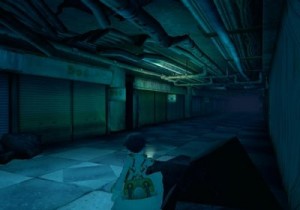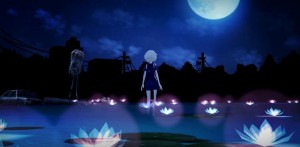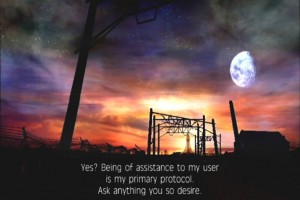Gaming love letters: Fragile Dreams
Warning: This article contains intense, intense spoilers regarding the game Fragile Dreams: Farewell Ruins of the Moon. If you intend to play the game, or simply have not played it yet, I highly recommend skipping the article altogether.

Preface: I’m not sure my feelings about Fragile Dreams really translated all that well in my review of the game for one reason or another, and I feel the need to really get this all out on paper. I realize it’s a very long read, but I hope some of you enjoy it and agree/disagree with me. If you do, be sure to let me know in the comments section!
The idea of humanity is one that proves hard to define, and something that very few people have managed to portray successfully beyond the confines of the human mind. Authors and poets and directors have struggled with this very idea for centuries, and very few have truly succeeded in translating to an outlet the mark humanity has left, and the way that mark describes us as a whole. The entire purpose of Fragile Dreams is to bring up the topic of our existence, and to show us that there is far more to life than simply materialistic desire and technological advancement. With that, Seto begins on his exploration of this desolate world he has come to know so well. He knows neither why nor how the world has become as empty as it has, he simply knows that it has.
Soon after leaving the observatory at the beginning of the game into the moonlit night, Seto comes upon a young girl who is singing to herself, and the metaphor for true humanity in the game is born. Oblivious to Seto’s presence, the girl sings a song about the quiet, desolate world and the beauty of the calm moon hovering above the horizon. She is, as far as players are aware, the only human contact Seto has had outside of his grandfather for his entire life, and he is completely transfixed by her. Unfortunately, his profound clumsiness causes him to step upon a children’s toy, which squeaks and echoes through the barren night. She notices Seto, falls from atop the fallen pillar she was perched upon, and lays silent. This moment in the game provides a catalyst for everything Seto does beyond the walls of the observatory, as he finally touches another human being with whom he can relate to. After this short moment of tranquility, however, the girl awakens and (supposedly out of fear) runs off into an underground train station.
After this encounter, it is clear what the girl (whose name is unknown at this point) means to Seto, and he runs off into the station after her. After all, as far as he knows, she is the only living human being left on the planet, and because of that, she comes to represent what all of us should hold of the highest importance: The relationships we have between us. Likewise, Seto is the representation of the human race, post-current generation. He is what the human race should be, and what the human race could be, had it the forethought to throw its obsession with technology and immoral practices out the window. However, as the next section of the game shows us, the current footprint that we have in place to leave is not one that can be considered honorable or of great importance.

The next section of the game takes place in an old, now-abandoned, underground mall. In his pursuit of the silver-haired girl, and subsequently his pursuit of humanity, Seto is taken past everything we (the current, 2010 generation) have left in the hour of our death. There are 2 very important things about the underground mall: Firstly, the posters and advertisements that are scattered about the walls and in the rooms of the complex. Everything that is seen relates to one of 4 things: fast cars, action movies, sexual appeal, or miracle cures. There are posters selling R-rated films, boxes filled with all-purpose cleaning solution, advertisements for the newest generation of cars, and booths with banners marketing the idea of plastic surgery. All of it relates to purely materialistic goods that improve the way someone looks or the number of things someone can do and how fast they can do it, and if one were to take a look around at the real world, would they find much different? Another thing that presents itself in the mall is a merchant-like figure, something that many people would call a gaming-norm. What’s odd about Fragile’s “merchant” is how he looks, and the manner in which he presents himself. He is wearing an oddly colored outfit with a large, mascot-like chicken head perched on top, and he comes and goes as he pleases, with no warning and no way to avoid him. What this may be taking a look at is the idea of commercials and what they do to us when we watch them.
Commercials, be they on TV or at a movie theater or on billboards, are things that are used to sell products, and you have no control over when and how you see them, much like this merchant. He comes and goes as he pleases, seemingly at random. Additionally, commercials often hide their products behind a mask, hitting the viewer with bells and whistles to distract them from perhaps the true idea of the advertisement. In the same way, the merchant wears a large chicken mask and a vocabulary filled with nothing but nice things to say to hide the fact that he is (or perhaps, may be) just another person trying to make money. Society as we know it has grown so fond of this commercialistic ideology, one could argue that the things that are truly important (relationships, emotions, connections with real people) have been completely forgotten in its wake. This is what Fragile takes a look so deeply at with the scenes in the underground mall and the merchant’s role in the game, beyond simply supplying us with items and weapons to survive. The main purpose of Seto’s visit to the mall, however, in terms of the overarching story of the game, is to act as an introduction to a new “character”, the Personal Frame.
The “Personal Frame” (or “PF” for short) is the name of a robotic backpack that Seto finds abandoned in the underground mall. It seems to be in danger from the flooded room in which it is hanging, since electronics and water don’t generally mix well, and Seto “rescues” it and brings it along with him on his journey. The Personal Frame is a computer designed to help alert its users to danger, and provide information on things to which they require it. In the scope of analyzing the human condition, PF represents relationships that people of this day and age have with technology, and while it may seem obvious at first, the metaphor goes much deeper, arguing even that relationships with inanimate objects are of equal importance as relationships with other human beings. As Seto journeys with PF, “she” (the robotic voice can be attributed to a female) talks to him, offering advice, companionship, and seemingly desiring such companionship herself. At one point, she even tells Seto that talking is her favorite thing to do, and she is so thankful that he is here to let her talk. Drawing a conclusion from the idea that machines, inanimate objects, and robots cannot and never will be able to feel emotion, one could argue that this display of emotion is unrealistic and should not be taken seriously. However, there is a method to the unrealities of Fragile Dreams, and it is a method which begs the question of what really makes us human, versus what makes a machine inhuman. Over the course of their relationship, PF seems to develop feelings for Seto, and who can blame her? She has been alone for likely many years, and seems completely oblivious to the fact that her “emotions” are not real. As far as she is concerned, there is no difference between her electronic emotions and Seto’s human emotions, and if all preconceptions and taboos are removed, there really is no difference between the two at all. Seto, however, does not seem to respond to these emotions put with faint breathes of feeling towards her. It’s a moment of sadness, yet almost sweet because finally she has someone to talk to. With the evolution of society has come so many ideas and rules for how our relationships should be, and which are more important than others. This is a theme explored throughout Fragile Dreams, alongside the arguably more important idea of humanity’s presence after it has all but
disappeared.
When Seto leaves the underground mall for the first time, he walks out onto a plain and into a scene of pure beauty. The sky in this area is painted with swirling colors and stars, while the moon lays low and large over the distant horizon. It is a moment of pure serenity and solemn beauty, because despite this wonderful sight, Seto has no one to share it with but a computer and the silent world. He speaks to himself about the beauty of the scene, and gets almost lost in the moment before PF interrupts him with her primary function of giving its user data. She explains that this beautiful phenomenon is the result of particles released into the air, or some other meteorological nonsense that was the result of the elimination of the human race, to which Seto simply replies “Mmm… Yea…” and other sparing words. The purpose of this is to show something very important about the world, and how oblivious we are to it due to our obsession with quick, mindless technology and shallow greed. Only after we have gone extinct does the true beauty of the world reveal itself, and how truly beautiful it is. This theme recurs on many occasions throughout Fragile, and each time the sights get more and more beautiful, and more and more surreal.

The end of Seto’s journey through the mall is also the end of his relationship with PF, and the catalyst to his realization of what relationships really are. Literally moments away from lifting himself into night and out of the cramped mall, PF exclaims something to the effect of “Batteries running low. Please replace or risk damage of data.” Seto, at first, is not sure what this even means. He asks PF what to do, bits of emotion escaping into his voice, but her robotic tone simply repeats that same phrase over and over. As the phrase begins to die out and the light on her apparatus begins to fade, Seto becomes more frantic, hurriedly asking her what she needs and what he can do to help her. Of course, all traces of help for her have died out with the death of humanity, and after her last “breath” has nearly escaped, she takes a short soliloquy as a tribute to Seto for truly helping her have what she considers the best time of her life. Upon hearing this, Seto loses all control over his emotions and his tears begin to fall as he begs her not to leave him. Of course, his efforts are in vain and Personal Frame’s battery eventually runs out. He takes many moments to grieve over the loss of his first true friend, and afterwards buries her in the small underground room in which she died. This, much like PF in general, questions the idea of what relationships really are, and what a relationship with a human means compared to the relationship with, say, a robot. The inter-human relationships that have been formed are held to such high esteem, but what Fragile points out is that there is a very finite difference between “legitimate” relationships with humans, and a relationship with artificial intelligence. This forces us to think about what separates a real relationship from an artificial one, and that’s the purpose of the game altogether.
The actual story of Fragile beyond the symbolism and commentary is one of troubled minds and the facade of human society. About 9 hours into the game, players learn that something called “Operation Glass Cage” is to blame for the vanishment of the human race. Operation Glass Cage was the collective work of some of the world’s greatest scientists as a way to allow the entire world to communicate without speaking, as some animals do, by way of merely projecting their thoughts. At first, it is thought that this would be a fantastic idea: Finally humans could portray emotions that could not be shared otherwise, due to the limitations of spoken word. The project merely needed a “catalyst”, or a human who could act as the “on” switch for the project. When the venture was underway, the entire world was in a bustle of excitement, knowing that the next time they fell asleep would be the last time they would be confined to the language which is so crude for portraying their emotions. When they awoke, they would be renewed as humans and their potential would be unlocked beyond their wildest dreams. However, most of them never awoke. One by one, as they went to sleep, they failed to awaken ever again, and gradually the human race fell asleep for the last time. In their obsession with technology, they have forgotten that which could be considered the most important, and destroyed their entire race in the process. This naive action by this foolish race is meant to represent us today, and the rush to have the smallest or fastest or cheapest or nicest piece of some material thing that, in retrospect, matters very little. It also represents a direction that life may be headed; perhaps our obsession will overtake everything and everything will be lost because of it. If the path being traveled continues onward, that very well could be the case.
Throughout Fragile Dreams, Seto comes across items that he collects, and at specific points in the game these items can be examined and memories from their previous owners can be listened to. These memories are presented in a soliloquy by the owner’s voice, and discuss life as it was before the human race was wiped out. They are used in many ways, but one specific memory deals with the idea of how humans are living their lives now, and how time is wasted on mindless things rather than on important things like relationships. In it, a young girl tells of her adolescent love with a boy who is obsessed with botany and the creation of new plants by way of genetic engineering. He vows to make a plant that will glow different colors according to the time of day, and dedicate it to the love of his life: The female narrator. As time goes on, however, he obsesses over his botanical studies, goes off to college, and forgets about her. During this time, Operation Glass Cage goes into effect, and the human race perishes. Does the boy regret his decision? There’s no way to tell, but the nature in which the memory is presented leads the player to the conclusion that this botanist wasted his time on something trivial, passing up the opportunity for that which is most important to being human.
Similarly to how the now-dead human race in Fragile takes on meaning as the generation that is currently living on earth, Seto’s grandfather is more than just a catalyst to begin the story. He is the realization that humanity must have in order to end this cycle of materialistic debauchery that caused humanity to die out in the first place. He says in his letter, “It’s strange, really. For having wasted so much of my life… Now that the end is finally in sight, I never dreamed I’d feel like this. Only the time I spent with you gave meaning to my worthless life.”. The old man, who was once part of that generation of mindless materialities, realizes that he has done nothing but waste his life on things that bear no real importance. What matters are not the things that one owns, but the relationships they form and the people they affect. The old man now realizes this, as he dies, and is, in essence, the start of a brand new race of people who know nothing but these relationships and emotions. Seto knows not materialism, because there is no materialism left for him to know or to latch onto, and likewise, the human race before Seto knew almost nothing but such a thing, for that is the society that has been crafted.

Later on in the game, Seto meets a young boy, like himself, named Crow. Crow is, essentially, the first “peer” Seto has ever had, and is important for two reasons: Firstly, after a drawn-out sequence of a sort of “hide-and-seek” game between the two boys, Crow does something unexpected: He kisses Seto. The importance of this little motion is really that it is not important at all. What surprises players about the sequence is based almost solely on the preconceptions of the society that exists today, rather than on a true, in-and-of-itself surprise. Seto is surprised as well, exclaiming that he has never kissed someone before, but Crow merely shrugs. “Isn’t that what friends do?”, and perhaps he is right. Without being raised in any way with any preconceptions, there is nothing wrong with kissing to show affection, no matter who it is to. Crow feels this way, and after a moment of though, Seto does as well. This becomes important later on in the game, as Crow is really Seto’s only true friend thus far in his journey, when Seto discovers that Crow is, in fact, a robot. Just like Personal Frame, his battery begins to die when they meet again inside an old scientific laboratory after many days apart, where they have one final conversation which is of utmost importance to Fragile’s message about relationships.
“That’s right, you ain’t looking at a human. I’m more like these discarded dolls around me. Nothing about me is human.”
“Maybe, but you’re still my best friend in the world!”
“You listening? I’m not even alive.”
“You’re my friend…”
“But I’m not human.”
“You’re my friend, damn it!”
Regardless of the fact that Crow is not human, nor was he ever, nor will he ever be, Seto still considers him his friend. He doesn’t care that he’s more like a doll, or that he’s a robot. In the same way, the we make these same emotional attachments to Crow, and when we discover that he is not human, we can’t help but agree with Seto. It does not matter who relationships are formed with, because they have the same effect regardless. This, more than anything, is the main message of Fragile Dreams.
Before it was put into effect over the entire earth, Operation Glass Cage was tested on the scientist who developed it, Shin, and the results were a success. Shin could now read the thoughts of others around him without effort, but what he found was not what he desired.
“When I listened to the thoughts of those all around me, all I heard was jealousy and contempt. They were wolves in sheeps clothing. Even the elderly were regarded not with respect, but with disdain. Whatever empathy may have been felt for others was quickly trampled by people’s self-interest. So long as that bitterness remains in the minds of men, this thing we call ‘society’ will be nothing more than a farce.”
Fragile Dreams brings up the idea that society is truly just a facade where everyone merely pretends that they are what is considered “right” and “good”, but in reality we are simply filled with contempt and self-interest. And perhaps it is a justified accusation to make. When surrounded by others, people hold their tongues and speak with much more kindness than they do in the privacy of their homes. With the evolution of the internet, we see hundreds of thousands of people posting hateful, racist, sexist, or otherwise offensive comments about things from politics to human rights, all behind the mask of a little avatar. Never would they make such comments if their identities were known, but the fact that they make them at all, and in such numbers, speaks for their true personalities behind the facade of societal acceptances.

As a manner of truly bringing this message out to players, Fragile Dreams uses one final piece of in-game juxtaposition, by using musical cues to actually explain the importance of relationships. Whenever you walk around the the world of Fragile, no music plays. The only times tri-Crescendo decided to add music to the mix was when Seto is in the presence of another conscious, which shows that the moments with relationships in them are important. They stand out because of the hauntingly beautiful score to the game, which comes and goes only at these key points. This reinforces the idea of relationships being the most important element to human life, and serves to provide an even more powerful story to the player.
Fragile Dreams is the type of game that comes around once in a blue moon, if ever before. There have been movies and books in the past that, when watched or read, affect us in ways that make them think about how they live their life, and take those influences with them beyond the end of the story, and Fragile Dreams is as good, or better than what has been accomplished with those outlets in the past. What is important about the message of Fragile is how clear it is: Humanity is destroying emotion and replacing it with materialistic nonsense. What emotion is in Seto’s world that is neither dead nor electronic? Only Ren, who is the representation of what is important beyond technology and materialism.We are far too obsessed with technology and materialism. Relationships with other people, be they human or inhuman, are what truly matter in life, and if things do not change soon, we may fall to the same fate as the humans in Fragile Dreams: Farewell Ruins of the Moon.